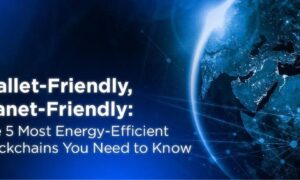Among the various players in the decentralized technology landscape, IOTA has emerged as a promising contender with a unique approach to decentralized systems. This article will explore IOTA’s vision for the future of decentralized technology, examining its advantages, limitations, and potential impact on various industries. Start your trading journey by investing in a reliable trading platform like immediatetradepro.com.
Decentralized Technology Landscape
Decentralized technology has become a popular topic in recent years due to its potential to provide a more secure and transparent system than traditional centralized systems. The most well-known decentralized technology is blockchain, which is used for cryptocurrencies such as Bitcoin and Ethereum. However, there are other decentralized technologies that are emerging as potential alternatives to blockchain, such as IOTA.
Blockchain is a distributed ledger technology that uses a network of computers to verify and record transactions. It is decentralized because there is no single authority or central party controlling the system. Each participant in the network has a copy of the ledger, and every transaction is validated through a consensus mechanism, typically through proof of work or proof-of-stake. This consensus mechanism ensures that the information stored in the blockchain is accurate and tamper-proof.
However, blockchain has some limitations, such as scalability and energy consumption. The current consensus mechanism used by many blockchain networks requires a large amount of computational power, which can lead to high energy consumption and slow transaction processing times. This is where IOTA comes in as a potential alternative to blockchain.
IOTA uses a different decentralized technology called the Tangle, which is designed to be more scalable and energy-efficient than blockchain. The Tangle is a directed acyclic graph (DAG) that is structured differently from blockchain. Instead of blocks, the Tangle uses transactions that are connected to each other in a non-linear way. This means that each transaction in the Tangle can confirm multiple other transactions, making the system more scalable.
Another advantage of the Tangle is its energy efficiency. Unlike blockchain, which uses a consensus mechanism that requires miners to perform complex computations, the Tangle uses a validation mechanism called Coordinator. The Coordinator ensures that the Tangle is secure and stable until it becomes large enough to operate on its own, without the Coordinator’s intervention.
- Understanding the IOTA Foundation and Its Mission
- An analysis of IOTA’s use cases in the insurance industry
IOTA’s Vision for the Future of Decentralized Technology
IOTA’s vision for the future of decentralized technology is centered around its Tangle architecture, which is designed to be scalable, secure, and energy-efficient. IOTA’s goal is to create a decentralized network that can support a wide range of use cases, from machine-to-machine (M2M) communication to Internet of Things (IoT) devices and beyond.
One of the key aspects of IOTA’s vision is its focus on M2M communication. The Tangle is designed to enable machines to communicate and transact with each other directly, without the need for human intervention. This can have a significant impact on various industries, such as logistics, manufacturing, and transportation, where machines can share data and coordinate with each other to optimize processes and reduce costs.
Another aspect of IOTA’s vision is its potential to provide a more secure and transparent system for various applications. The Tangle’s consensus mechanism, which uses a Coordinator to ensure the security and stability of the network, can help prevent attacks and ensure that the data stored on the network is accurate and tamper-proof. This can be particularly important in industries such as finance, where security and transparency are critical.
IOTA’s vision also includes its efforts to become a platform for various applications and services. Through its partnerships with various companies and organizations, IOTA is exploring various use cases for its technology, such as digital identity, supply chain management, and decentralized marketplaces. IOTA’s goal is to become a foundational layer for various decentralized applications, providing a more efficient and secure platform than traditional centralized systems.
In addition to its focus on technology, IOTA’s vision also includes a strong emphasis on community building and education. IOTA aims to create a community of developers, researchers, and enthusiasts who can collaborate and innovate on top of its technology. To achieve this, IOTA has established various initiatives, such as the IOTA Foundation and the IOTA Ecosystem Fund, which provide funding and support for projects that use IOTA technology.
Conclusion
In conclusion, IOTA’s vision for the future of decentralized technology is centered around its Tangle architecture and its potential to provide a more scalable, secure, and energy-efficient platform than traditional decentralized technologies such as blockchain. With a focus on M2M communication, community building, and partnerships with various industries, IOTA aims to become a foundational layer for various decentralized applications, providing a more efficient and secure platform than traditional centralized systems.
Disclaimer: This is promotional marketing content. The presented material by no means represents any financial advice or promotion. Be sure to do your research and acknowledge the possible risks before using the service of any trading platform.



































